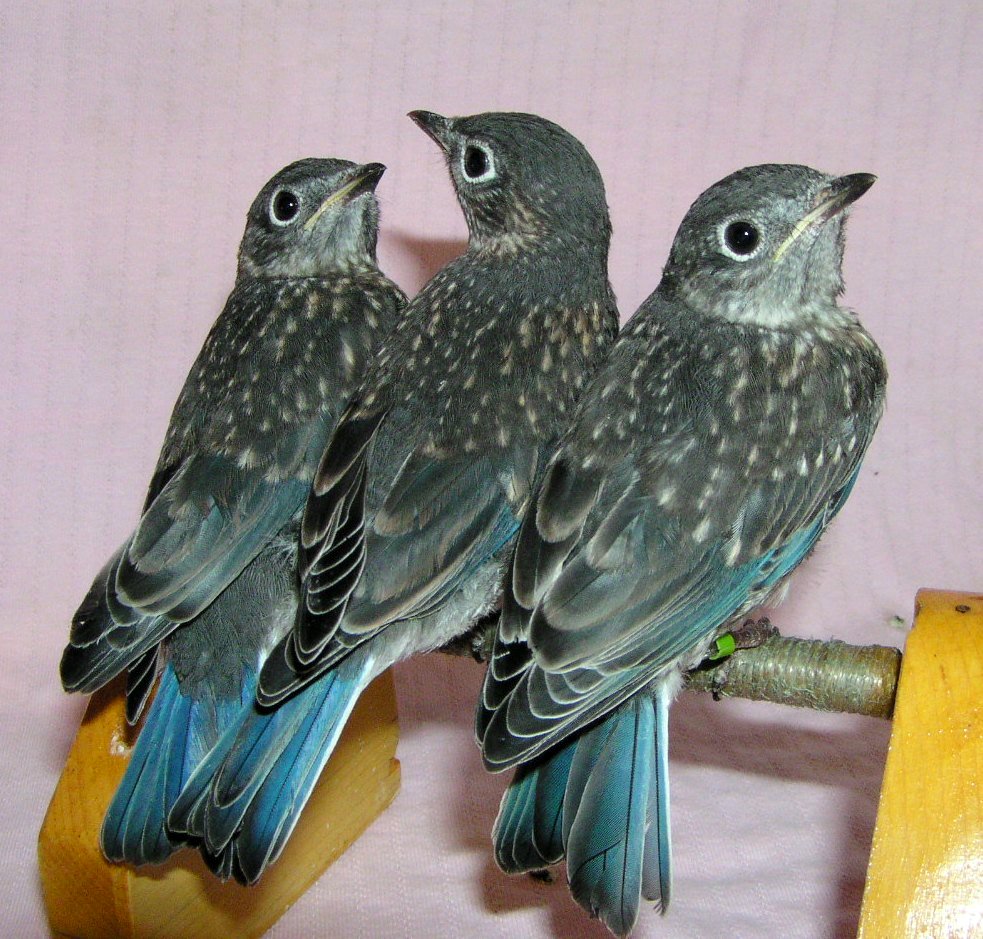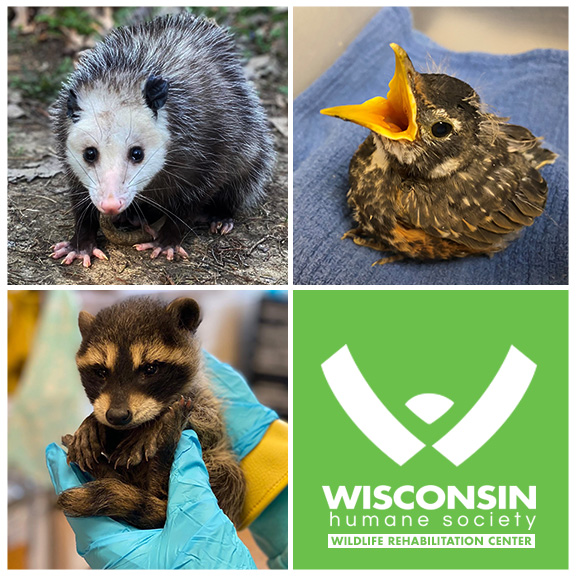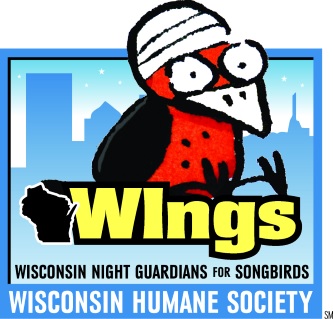Sick or Injured Birds
CLICK HERE for a print-friendly PDF and photos!

Situation:
You’ve found a sick or injured wild bird and you’d like to try to help it.
Why This Happens:
Some common causes for birds becoming injured include being hit by a car, colliding with a window, becoming entangled in fishing line, and being attacked by a predator. They may also become sick from a wide variety of parasitic, viral, bacterial, and fungal diseases such as West Nile Virus and avian botulism poisoning.
FAQs & Humane Solutions:
“A bird just collided with my window! What should I do?”
If a small bird (such as a robin or a cardinal) has collided with your window or otherwise appears to be injured, you can use one of the following methods to contain it:
- Approach the bird slowly and quietly, ideally from behind, and capture it with your hands by gently grasping it around the body from behind.
Caution: while most small birds have weak bills and feet and are not capable of biting or grasping very hard, some large-billed songbirds like Northern Cardinals, Rose-breasted Grosbeaks, and American Crows CAN bite hard. It is recommended that you wear a pair of lightweight leather gloves when capturing these, and small birds of prey like Eastern Screech Owls and American Kestrels. For guidelines for capturing larger birds such as ducks, geese, and larger birds of prey, see below. - Cover the bird with a cloth and use the cloth to pick it up.
- Gently scoop the bird into, or cover with, a cardboard box.
- Capture the bird by placing a fine-mesh net such as a butterfly net or fishing net over it. With the bird still inside the net, pinch the net above the bird to keep the bird from escaping, and then reach in to grasp the bird by hand and transfer it to a box, paper bag, or other suitable container. Don’t try to lift up an edge of the net to slip your hand underneath it; lifting the edge of the net will give the bird a chance to escape (see photos in the linked PDF).
Once captured:
- Place the bird in a box or paper grocery bag that has small, pencil-sized air holes poked through the side and/or top. Include a ravel-free cloth (pillow case or T-shirt), paper towels, or newspaper on the floor of the container.
- Close the container securely and place it in a dark, quiet, warm place where it won’t be disturbed (keep children and pets away).
- Call your local wildlife rehabilitator. If you are in Milwaukee County, please call the WHS Wildlife Rehabilitation Center for further advice at (414) 431-6204.
Note: Birds collide with windows because of the reflections on the glass. Reduce the risk of window collisions by applying Whispering Windows static window clings, WindowAlerts, or ColliEscape Bird Tape on the outside of problem windows. Each of these products is available through the Wisconsin Humane Society Online Store. For more information about preventing bird window collisions, visit our WIngs page.
“There is a bird on the ground, how do I know if it’s injured or sick?”
Indications that a bird may be injured or sick include:
- One of its wings is drooping more than the other or both wings are drooping
- The bird is bleeding
- A leg or wing is sticking out at an odd angle
- It is encumbered by materials such as fishing line or other debris, or is coated with oil or some other contaminant
- It cannot fly, or it flies poorly (weak or crooked flight)
- It has obvious signs of illness such as its eyes are swollen shut, it can’t stand, its head is twisted sharply to one side, or the head even appears to be upside down
- It is a water-bird such as a duck, loon, or grebe that appears to have been washed up on the shore, or is found far away from water where it can’t take off
“I’ve found a large injured (or sick) hawk (or owl, heron, duck, goose, loon, etc.). What can I do to help it?”
You should be very careful when trying to capture/contain any of these birds. Some have sharp talons and others have sharp or powerful bills. They use these “weapons” to defend themselves from predators, and they don’t know that you are trying to help them.
When attempting to contain any bird that has a long, sharp bill (e.g. a heron or crane) you should wear safety glasses or a plastic face shield to protect your eyes. These birds defend themselves by jabbing with their bill, often at their “attacker’s” face. Ideally, these birds are then contained by holding a large blanket or bed sheet open in front of you and using it to drape completely over the bird.
For any bird that has sharp talons (e.g. a hawk or owl) you should wear thick leather gloves, ideally, welding-type gloves with gauntlets that protect your forearms. However, these birds may still be able to penetrate the gloves with their talons, so don’t try to grab these birds directly by hand. Instead, for these and any other larger bird such as a duck or goose, cover the bird with a sheet or blanket (see below), or use an empty box or similar container. After covering the bird with the box, gently slide a flat piece of cardboard or similar rigid material under the bird to contain it in the box. You'll then need to tape or tie the box to the flat piece of cardboard to make sure the bird can't get out.
If you have any questions about containing a bird that needs assistance, please call us at 414-431-6204.
“After I contain the bird, is there anything special I should or should not do?”
- Stressors such as loud noises, talking, excessive handling, or the close proximity of pets or people can create life-threatening stress for the bird. You should minimize stress by not playing your car radio during transport and by keeping talking and other noise to a minimum. Do not needlessly look in on the contained bird. Don’t talk to it or pet the bird, as these will not calm it, but only cause more stress.
- Do not give it food, water or medication.
- Do not lay the bird on its back. Birds have more difficulty breathing when they are on their back.
- Get the bird to a licensed wildlife rehabilitator AS SOON AS POSSIBLE. Once an animal is injured, the clock is ticking. The sooner an animal gets to a licensed wildlife rehabilitator, the better the chances for a good outcome. By law, you have a 24-hour grace-period in which to get the captured bird to a licensed wildlife rehabilitator
“I really want to help this bird I found, but I’m uncomfortable or incapable of trying to capture it myself. Can you come to rescue it for me?”
We are a non-profit organization with only a handful of staff members and we sometimes have as many as 500 animals in care in our wildlife hospital! Thus, as much as we’d like to, we are not always able to leave our hospital and the patients we are caring for to come out and pick up animals. We have trained wildlife rescue volunteers that may be able to help but are not always able to find a volunteer to help with every situation. If you can’t contain and transport the bird yourself, you may be able to enlist a family member, friend, or neighbor to help you.
If you absolutely can’t contain or transport a bird, or find a friend or neighbor to help you, by all means give us a call! If you are in Milwaukee County, we’ll do our best to get help for the bird you’ve found. If you are outside of Milwaukee County, you may call the Wisconsin Department of Natural Resources Call Center (1-888-936- 7463) for help finding a licensed wildlife rehabilitator near you or call us at (414) 431- 6204 and we can assist you with advice over the phone and help direct you to a licensed wildlife rehabilitator in your area.



